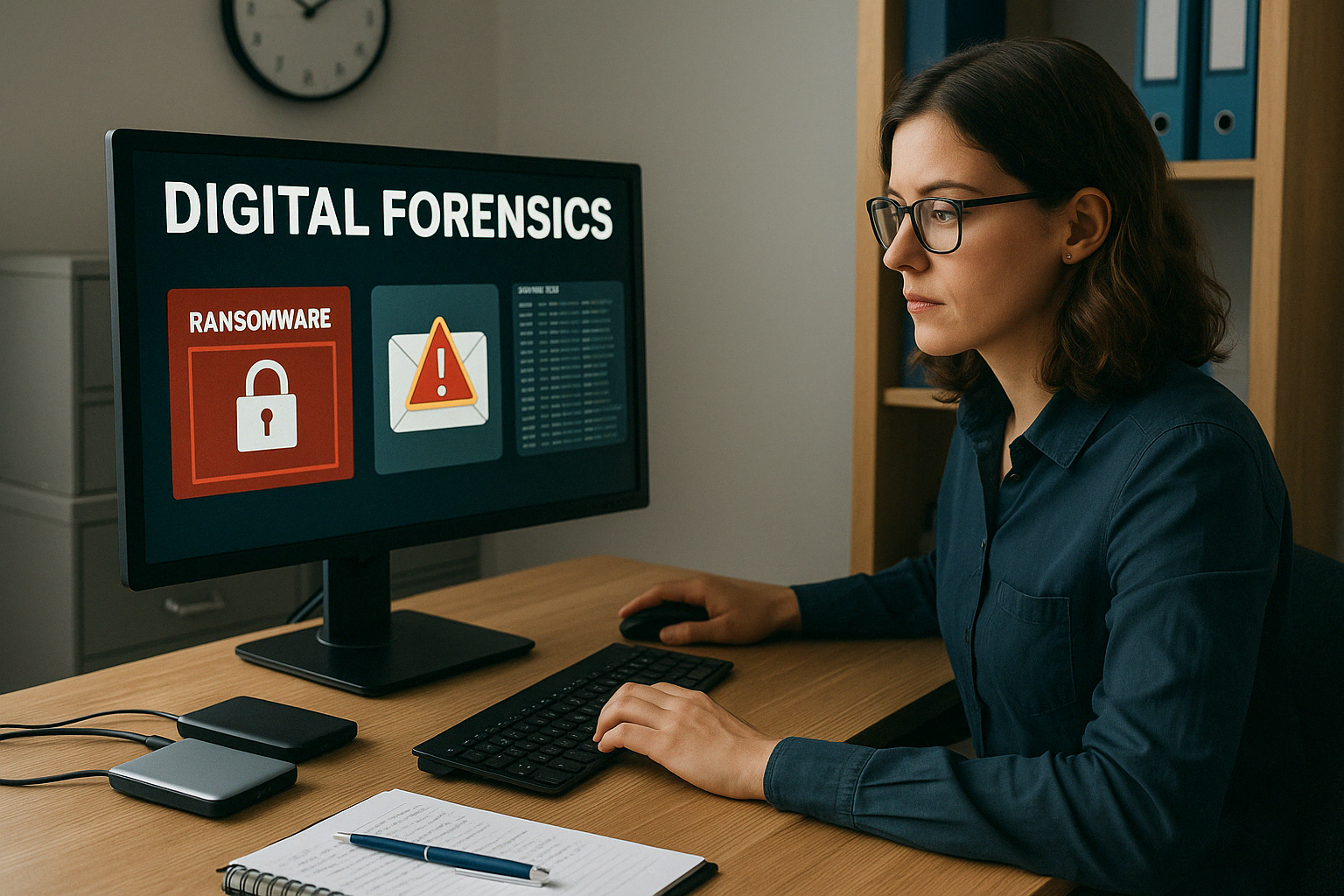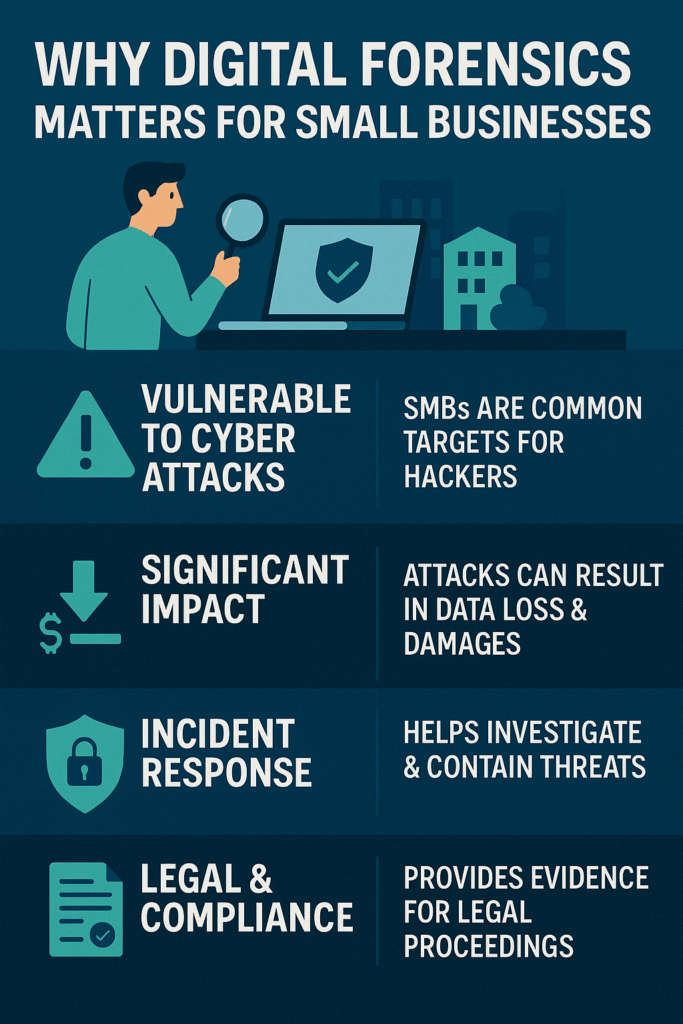
Digital forensics for small businesses is essential in 2025 as threats grow and data protection becomes more complex and regulated.
In today’s digital-first world, even the smallest business can be the target of a cyberattack. Whether it’s a data breach, employee misconduct, or accidental file deletion, understanding what happened — and how to recover — is critical. Digital forensics for small businesses is no longer a luxury—it’s a critical shield against modern cyber threats.
While many assume digital forensics is something only large corporations or law enforcement agencies need, the truth is: small businesses are increasingly using it to secure their operations, protect data, and ensure legal compliance.
In this beginner-friendly guide, we’ll walk you through what digital forensics for small businesses means, Learn more about how to respond to cyber incidents with our Incident Response Plan Guide.
why it matters, and how you can get started — even without a full-blown IT team. Learn more in our Cybersecurity Essentials for Small Business.
What Is Digital Forensics?
Digital forensics is the process of identifying, preserving, analyzing, and presenting digital evidence. It’s often used to investigate cybersecurity incidents, recover lost or deleted data, or examine suspicious activity on company devices or networks.
🔍 Think of it as the digital equivalent of dusting for fingerprints — but instead of a crime scene, the “scene” could be a corrupted hard drive, compromised email account, or breached cloud server.
Key Objectives:
- Determine what happened
- Find out how and when it happened
- Identify who was involved
- Preserve evidence for legal or internal purposes
—
Why Digital Forensics for Small Businesses Matters in 2025 ?

Many small business owners think they’re “too small” to be a target. Unfortunately, this mindset makes them even more vulnerable. Here’s why digital forensics matters:
Digital forensics for small businesses isn’t just a defensive tool—it’s a competitive advantage in today’s cyber-driven market.
1. Cyberattacks Aren’t Just a Big Business Problem
According to Verizon’s 2023 Data Breach Investigations Report, 61% of small businesses experienced at least one cyberattack last year. These attacks can cripple operations — or worse, leak sensitive customer data.
With digital forensics, you can:
- Detect the source of the breach
- Assess the damage
- Prevent future incidents
2. Legal and Regulatory Compliance
If your business operates in healthcare, finance, or e-commerce, you’re likely subject to data privacy regulations like GDPR, HIPAA, or CCPA. After a data incident, forensic documentation can help prove that you took the proper steps to investigate and report the breach.
For more about documenting digital investigations, check out our Chain of Custody Template.
3. Internal Threats Are Real
Unfortunately, not all threats come from the outside. Digital forensics can help uncover employee misconduct, data theft, or unauthorized file access.
🧑💼 Example: A former employee deletes sensitive client files before leaving. Forensic analysis can help recover the files and trace the activity.
—
Basic Digital Forensics Process (Step-by-Step)
Using digital forensics for small businesses allows owners to detect attacks early and preserve critical evidence for recovery.
Let’s simplify the digital forensics workflow for non-technical teams:
Step 1: Identify the Incident
What triggered the investigation? Was it a suspicious login, file deletion, or a malware alert?
⏱️ Act quickly — every second matters when preserving digital evidence.
Step 2: Preserve the Evidence
Before anything is altered or overwritten:
- Create a copy (image) of the system or device
- Secure logs, emails, or external drives
- Don’t restart or “clean up” the system yet
Use free tools like FTK Imager or Autopsy for creating disk images.
Step 3: Analyze
Examine the digital copy for:
- Suspicious logins or activity timestamps
- File access, edits, deletions
- Installed software or malware traces
Tools like Wireshark can help analyze network traffic; Loggly or OSSEC can assist with log analysis.
Step 4: Report Findings
Document everything: timelines, screenshots, recovery efforts. This can support legal action or help meet compliance requirements.
Learn more about cybersecurity resilience and incident handling by referring to the NIST Cybersecurity Framework.
—
Common Digital Forensics Tools for SMBs
Here are tools you can use (many are free or open-source):
| Tool Name | Function | Free / Paid | Difficulty |
|---|---|---|---|
| Autopsy | File recovery & analysis | Free | Easy |
| FTK Imager | Disk imaging & duplication | Free | Medium |
| Wireshark | Network traffic inspection | Free | Medium |
| Volatility | RAM analysis | Free | Advanced |
| Magnet AXIOM | Full forensic suite | Paid | Easy |
How to Get Started (Even Without an IT Team)
Even without a full IT department, small businesses can start implementing digital forensics for small businesses strategies effectively.
You don’t need to hire a forensics expert to get basic protection in place. Here’s how to start:
✅ Schedule Regular Backups
Backups are your safety net. Use tools like Acronis, Backblaze, or Dropbox to back up critical data daily.
✅ Use Endpoint Monitoring
Deploy software like Bitdefender or Malwarebytes on company devices to track suspicious activity.
✅ Establish an Incident Response Plan
Even a simple checklist — who to call, what to isolate, how to log activity — can make a huge difference during an incident.
The CISA Small Business Cybersecurity Guide offers free tools, templates, and resources designed specifically for small businesses.
✅ Partner with a Managed Security Provider
If budget allows, consider outsourcing digital forensics or cybersecurity management to a specialized provider.
📚 Ready to build even stronger defenses? Explore our Cybersecurity Tips for Small Businesses today.
Personal Experience: How Digital Forensics Saved a Local Law Firm
One of our clients — a 5-person law firm — faced a serious breach when client case files disappeared from their shared drive.
Initial assumptions pointed to hardware failure, but a quick forensic audit using Autopsy revealed that a departing associate had deleted the files manually just before leaving.
The firm was able to:
- Recover all deleted files
- Confront the employee with documented evidence
- Review internal access policies
It was a tough situation — but without digital forensics, they would’ve lost crucial legal documents and client trust.
—
Conclusion: Small Steps, Big Protection
Investing early in digital forensics for small businesses saves money, reputation, and operational continuity.
Building even a basic capability for digital forensics for small businesses drastically improves cyber resilience and incident response. For small businesses, it’s not about becoming a cybersecurity expert overnight — it’s about being prepared.
Start small:
- Audit your devices
- Learn the basics of data preservation
- Install monitoring tools
- Have a plan in place
The peace of mind you gain is worth every minute invested.
—




Comments (1)
Common Cyber Threats That Digital Forensics Can Solve (2025 Guide) -says:
18/04/2025 at 12:12 am[…] What Is Digital Forensics Apr 16, 2025 […]